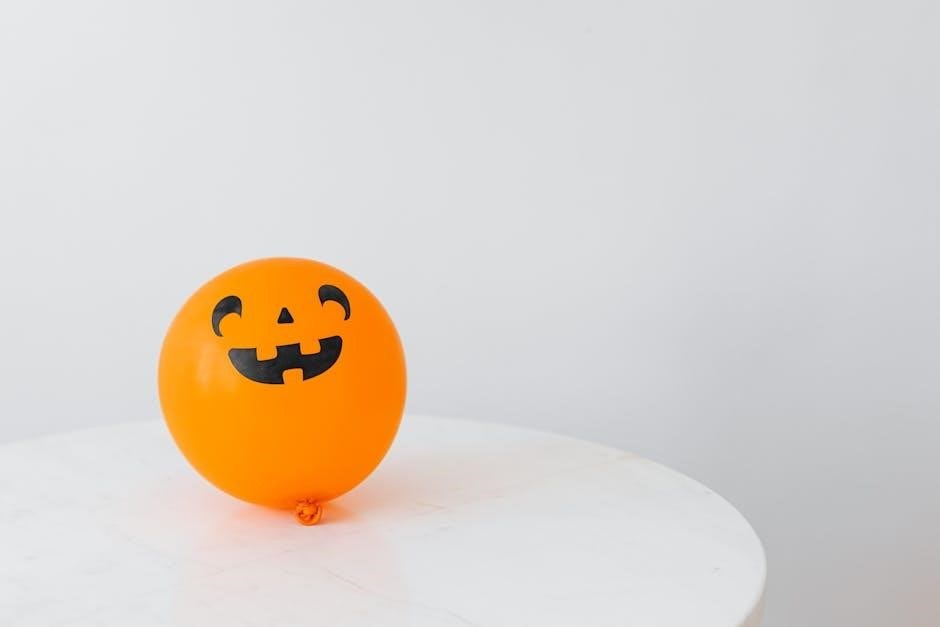Agatha Christie’s “Halloween Party” PDF: A Comprehensive Guide
Discover the chilling world of Agatha Christie’s “Halloween Party” through readily available PDF versions. Fontana’s 1987 edition, and others, are digitally accessible. Explore this classic mystery online, with images found on platforms like Pinterest and Russian State Youth Library resources.
Agatha Christie’s “Halloween Party,” first published in 1969, represents a fascinating, and somewhat unusual, entry within her extensive catalog of detective fiction. Unlike many of her novels featuring the iconic Hercule Poirot or Miss Marple, “Halloween Party” initially appears as a standalone mystery, offering a different flavor to Christie’s established formula. However, Poirot is ultimately brought in to solve the perplexing case.
The story unfolds during a children’s Halloween party held at Woodleigh Manor, a grand estate in the English countryside. The seemingly innocent atmosphere is shattered when thirteen-year-old Joyce Reynolds boasts of witnessing a murder. Shortly after, Joyce herself is found dead, transforming a childish claim into a grim reality. This shocking turn of events sets the stage for a complex investigation, steeped in secrets and hidden motives.
The availability of the novel in PDF format, including editions like the Fontana print from 1987, has broadened its accessibility to readers worldwide. Online platforms, such as Pinterest, showcase various cover designs of the book, highlighting its enduring appeal. These digital versions allow enthusiasts to delve into the mystery conveniently, preserving Christie’s masterful storytelling for generations to come. The story’s enduring popularity is reflected in its continued presence in digital libraries and online book repositories.
Plot Summary: The Core Mystery
The narrative centers around a Halloween party hosted by Rowena Drake at Woodleigh Manor. During the festivities, young Joyce Reynolds dramatically claims to have witnessed a murder years prior, though no crime was ever reported. Her boast is initially dismissed as attention-seeking, but the situation takes a sinister turn when Joyce is found drowned in an apple-bobbing tub shortly after making her declaration.
Hercule Poirot is called upon to investigate what initially appears to be an accidental death, but quickly reveals itself as a calculated murder. Poirot meticulously unravels a web of interconnected secrets within the local community, discovering that Joyce’s claim, however improbable, struck a nerve with several individuals.
The core mystery revolves around identifying the original murder Joyce supposedly witnessed and connecting it to her own untimely death; Numerous suspects emerge, each with plausible motives and concealed pasts. The investigation delves into long-held grudges, financial disputes, and hidden relationships, all set against the backdrop of a seemingly idyllic English village. PDF versions of the novel, like the Fontana 1987 edition, allow readers to follow Poirot’s intricate deductions closely, examining clues and red herrings alongside the renowned detective. The story’s complexity is enhanced by the unreliable nature of witness testimonies and the deliberate obfuscation of truth.
Main Characters and Their Roles
Hercule Poirot, the celebrated detective, is central to unraveling the mystery, employing his “little grey cells” to dissect the complex case. Rowena Drake, the wealthy and observant hostess of the Halloween party, provides a crucial setting and initial observations. Joyce Reynolds, the victim, initiates the plot with her startling claim of witnessing a past murder.
Miranda Butler, a local schoolteacher, possesses a keen understanding of the village’s dynamics and its inhabitants. Judith Butler, Miranda’s sister, adds another layer of complexity with her own secrets and connections. Michael Garfield, a local gardener, harbors a mysterious past and becomes a person of interest during Poirot’s investigation.
Alistair Blunt, an art collector, and his wife, Leopoldine, contribute to the atmosphere of suspicion with their aloof demeanor and hidden agendas. Olga Seminoff, a former governess, adds a foreign element and a potential link to past events. Accessing the story through a PDF, such as the Fontana 1987 edition, allows for detailed character tracking. Each character’s role is intricately woven into the narrative, with their motivations and relationships gradually revealed as Poirot delves deeper into the truth, making them all potential suspects in the unfolding drama.
Publication History and First Editions (Fontana, 1987)
“Halloween Party” was first published in the United Kingdom in 1969 by Collins Crime Club, marking another addition to Agatha Christie’s prolific output. The first US edition followed shortly after, released by Dodd, Mead and Company. However, the Fontana paperback edition of 1987 holds significance for its accessibility and affordability, becoming a widely circulated version.
Fontana, an imprint of HarperCollins, specialized in paperback reprints, bringing Christie’s works to a broader readership. The 1987 edition, often depicted with distinctive cover art on platforms like Pinterest, represents a key moment in the novel’s distribution. PDF versions frequently originate from scans of these later editions, including the Fontana print.

Early editions are highly sought after by collectors, but the Fontana edition provides a convenient and cost-effective way to experience the story. Digital copies, readily available as PDFs, often showcase images of these covers, preserving a visual record of the book’s publishing history. The Fontana imprint played a vital role in maintaining Christie’s popularity, ensuring her mysteries remained accessible to generations of readers, even in the digital age.
Availability of “Halloween Party” in PDF Format

“Halloween Party” in PDF format is surprisingly accessible, though sourcing legitimate copies requires caution. Numerous websites offer downloads, ranging from dedicated ebook stores to file-sharing platforms. However, the quality and legality of these PDFs vary significantly.
Online searches reveal numerous links, often accompanied by images of the Fontana 1987 edition cover, as seen on platforms like Pinterest. These images frequently serve as thumbnails for download links. PDF availability is boosted by the novel’s public domain status in some regions, allowing for free distribution.

Digital libraries and ebook retailers, such as Google Books and Amazon Kindle, often feature “Halloween Party” as a purchasable PDF or ebook. These sources guarantee a high-quality, legally obtained copy. Conversely, beware of websites offering free downloads from less reputable sources, as these may contain malware or violate copyright laws. Scanned versions, originating from physical copies like the Fontana edition, are also prevalent, though image quality can differ.
Legality and Sources for PDF Downloads
Downloading “Halloween Party” as a PDF raises important legal considerations. While Agatha Christie’s works are widely celebrated, unauthorized distribution constitutes copyright infringement. Legitimate sources include official ebook retailers like Amazon Kindle, Kobo, and Google Play Books, offering paid PDF versions.
Public domain status varies by country; in regions where the copyright has expired, free PDF downloads may be legal. However, verifying this status is crucial. Websites offering free downloads should be approached with caution, as many operate outside legal boundaries. Images found on platforms like Pinterest, linking to download sites, don’t guarantee legality.

Reliable sources often include university libraries with digitized collections and authorized ebook subscription services. Beware of file-sharing websites and torrent sites, as these frequently host pirated content. Opting for a purchased PDF ensures you support the author’s estate and receive a high-quality, virus-free file. The Fontana 1987 edition, while visually recognizable online, doesn’t inherently validate a download’s legality.
Themes Explored in the Novel: Deception and Childhood
“Halloween Party” masterfully explores the fragility of childhood innocence and the pervasive nature of deception. The novel centers around a boastful claim made by a young girl, Joyce Reynolds, who seemingly reveals a murder she witnessed, only to be found dead herself. This initial deception sets the stage for a complex investigation.
Christie delves into how adults often underestimate children, failing to recognize their observational skills and the secrets they hold. The children in the story are not merely witnesses but active participants, harboring their own knowledge and biases. Deception isn’t limited to the central mystery; characters conceal motives, relationships, and past events, creating a web of lies.
The Halloween setting itself contributes to the theme, a night traditionally associated with disguise and pretense. PDF versions of the novel allow readers to revisit these themes at their own pace, analyzing the subtle clues Christie weaves throughout the narrative. Ultimately, the novel questions the reliability of memory and the ease with which perceptions can be manipulated, even within the seemingly safe world of childhood.
Setting and Atmosphere: A Classic English Halloween
“Halloween Party” is steeped in a quintessential English autumnal atmosphere, vividly portraying a traditional Halloween celebration. The story unfolds at a grand country house, a staple of Christie’s settings, during a children’s Halloween party. This backdrop immediately establishes a sense of both festivity and underlying unease.
Christie expertly uses the setting to enhance the mystery. The dimly lit rooms, the costumes, and the games all contribute to a feeling of suspense and hidden identities. The rural English countryside provides a sense of isolation, amplifying the claustrophobia as the investigation unfolds. PDF versions of the novel allow readers to fully immerse themselves in this atmospheric world, revisiting descriptive passages at will.
The Halloween theme isn’t merely decorative; it’s integral to the plot, with its associations of disguise, secrets, and the supernatural. Images accompanying online resources, like those found on Pinterest, often capture this classic aesthetic. Ultimately, the setting isn’t just a location but a character in itself, influencing the events and heightening the tension throughout the narrative.
Hercule Poirot’s Involvement and Investigation Style
Hercule Poirot, though not initially present at the Halloween party itself, is drawn into the investigation following a shocking claim and subsequent murder. His involvement marks a shift from a local inquiry to a meticulously orchestrated investigation guided by his renowned “little grey cells.” PDF editions of “Halloween Party” allow for close examination of Poirot’s deductive reasoning as the story progresses.
Poirot’s style is characterized by a methodical approach, focusing on psychology and the subtle nuances of human behavior. He interviews suspects, carefully analyzing their statements for inconsistencies and hidden motives. He reconstructs the events leading up to the crime, seeking to understand the relationships and secrets within the community. Online resources and digital copies facilitate revisiting key dialogues and clues.
Unlike some of his earlier cases, Poirot relies heavily on the testimonies of children, recognizing their unique perspective and often overlooked observations. This novel showcases his ability to adapt his methods to the specific circumstances of each case. Readers can trace his thought process through the text, appreciating the brilliance of his deductions, readily available in digital format.
Key Clues and Red Herrings
“Halloween Party” is a labyrinth of subtle clues and deliberately misleading red herrings, expertly woven by Agatha Christie. PDF versions of the novel allow readers to meticulously revisit scenes, searching for overlooked details that contribute to the unraveling of the mystery. The initial claim of a past murder, dismissed as a childish boast, serves as the central catalyst, yet its veracity is constantly questioned.
Several characters present themselves as potential suspects, each with their own secrets and motives. Christie masterfully employs misdirection, leading the reader down false paths with seemingly incriminating evidence. The seemingly innocuous details about the victim’s personality and relationships prove crucial, yet are easily dismissed amidst the flurry of suspicion. Digital access enables easy cross-referencing of character testimonies.
Key clues are often embedded within seemingly casual conversations or observations, requiring careful attention to detail. Red herrings, such as the focus on certain individuals’ alibis, distract from the true perpetrator. Analyzing the narrative through a digital copy allows for a systematic examination of these elements, enhancing the reader’s detective experience and revealing Christie’s genius.
The Victim: Joyce Reynolds and Her Claim
Joyce Reynolds, the young and boastful victim in “Halloween Party,” initiates the central mystery with her audacious claim of having witnessed a murder. PDF versions of the novel allow for repeated readings, focusing specifically on Joyce’s character and the impact of her statement. Her assertion, initially dismissed as a child’s attention-seeking fabrication, sets in motion a chain of events leading to her tragic death.
The ambiguity surrounding Joyce’s claim is crucial. Was she genuinely recalling a past event, or was her story a product of an overactive imagination? Christie skillfully utilizes this uncertainty to create suspense and mislead both the characters and the reader. Digital access to the text facilitates a close examination of Joyce’s interactions and the reactions of those around her.
Her personality – precocious, attention-seeking, and prone to exaggeration – complicates the investigation. The question of her credibility becomes paramount, influencing the direction of Poirot’s inquiries. Analyzing the narrative through a PDF allows for a detailed assessment of Joyce’s character, revealing the subtle clues that ultimately illuminate the truth behind her fateful claim and untimely demise.
Motives of the Suspects
“Halloween Party” presents a complex web of suspects, each harboring potential motives for silencing Joyce Reynolds. PDF accessibility allows for meticulous re-examination of character interactions and hidden agendas, crucial for unraveling the truth. Rowena Drake, the hostess, possesses a past shrouded in secrecy, while Michael Garfield, a former gardener, carries resentment and financial difficulties.
The novel expertly explores themes of jealousy, revenge, and concealed relationships. Atticus Fenton, a local solicitor, and Olga Seminoff, a former actress, both have connections to past events that resurface during the investigation. Accessing the text digitally enables readers to track the subtle clues revealing each suspect’s potential involvement.
Poirot’s methodical approach uncovers a network of long-held grudges and carefully guarded secrets. The motives range from protecting reputations to concealing criminal activities. A detailed study of the suspects, facilitated by the PDF format, highlights the intricate connections and deceptive facades that Christie masterfully constructs, ultimately leading to the shocking revelation of the true killer and their compelling reason.
Critical Reception and Reviews of “Halloween Party”

“Halloween Party” garnered mixed, yet largely positive, reviews upon its initial publication and continues to be analyzed today, with PDF versions facilitating scholarly access. Contemporary critics praised Christie’s intricate plotting and atmospheric setting, noting its effective use of suspense and misdirection. However, some found the sheer number of suspects initially overwhelming, requiring careful attention to detail – a benefit enhanced by digital formats.
Modern reviews often highlight the novel’s exploration of childhood innocence corrupted by adult malice. The accessibility of the text in PDF format allows for close reading and annotation, aiding in the identification of subtle clues and thematic nuances. Many reviewers commend Christie’s ability to maintain reader engagement despite the complex narrative structure.

Overall, “Halloween Party” is considered a solid entry in the Poirot canon, demonstrating Christie’s enduring skill in crafting compelling mysteries. Digital access allows readers to compare different editions and analyses, enriching their understanding of the novel’s critical reception and lasting appeal. The book remains a popular choice for both casual readers and academic study.
Adaptations: Film, Television, and Stage
“Halloween Party” has seen several adaptations, bringing Agatha Christie’s intricate mystery to different mediums, often supplementing study via readily available PDF versions of the original novel. Notably, a television adaptation aired as part of the Agatha Christie’s Poirot series, starring David Suchet as the iconic detective. This version generally received positive reviews for its faithfulness to the source material and atmospheric recreation of the Halloween setting.
While a direct film adaptation hasn’t achieved widespread recognition, the television adaptation remains the most prominent visual interpretation. Stage productions, though less common, have also been mounted, offering a more intimate and theatrical experience of the story. Access to the novel in PDF format allows fans to compare the adaptations’ interpretations with Christie’s original vision.

These adaptations often highlight different aspects of the plot and character dynamics, providing varied perspectives on the core mystery. The availability of the PDF allows for detailed comparison, enabling viewers and readers to analyze how effectively each adaptation captures the novel’s suspense and thematic depth. Ultimately, these adaptations extend the reach of Christie’s work, introducing it to new audiences;
Similar Agatha Christie Novels: Comparisons and Contrasts
“Halloween Party” shares thematic and structural similarities with other Agatha Christie novels, particularly those featuring closed circles of suspects and investigations centered around seemingly innocent gatherings. Comparing it to “And Then There Were None” reveals a shared sense of isolation and mounting dread, though “Halloween Party” lacks the extreme premise of a deadly game. Accessing the novel in PDF format facilitates side-by-side analysis with these works.
Like “The Murder at the Vicarage,” “Halloween Party” features a village setting and a cast of characters with hidden secrets. However, “Halloween Party” distinguishes itself with its focus on childhood memories and the lasting impact of past events. The PDF version allows readers to easily revisit key passages and compare Christie’s narrative techniques across different novels.
Contrasting it with Poirot’s earlier cases, “Halloween Party” showcases a more reflective and melancholic tone. While maintaining the classic Christie formula of intricate plotting and red herrings, it delves deeper into psychological complexities. Studying the novel via PDF alongside others reveals Christie’s evolving style and enduring mastery of the detective genre.
“Halloween Party” and the Golden Age of Detective Fiction

“Halloween Party” exemplifies the hallmarks of the Golden Age of Detective Fiction, a period defined by intricate plots, logical deduction, and a focus on puzzle-solving. Published in 1969, it represents a late, yet masterful, contribution to this era, showcasing Christie’s enduring adherence to the genre’s conventions. Reading the novel in PDF format allows for focused study of these elements.
The novel’s reliance on a closed circle of suspects, a seemingly impossible crime, and the brilliant deduction of Hercule Poirot are all characteristic of the Golden Age. Compared to works by Dorothy L. Sayers and Ngaio Marsh, “Halloween Party” maintains a similar emphasis on intellectual rigor and fair-play mystery construction. Accessing a PDF copy facilitates detailed textual analysis.
However, “Halloween Party” also subtly reflects the changing social landscape of the late 1960s, hinting at anxieties beyond the purely criminal. The PDF version enables readers to examine how Christie balances traditional genre elements with emerging themes. Ultimately, the novel stands as a testament to Christie’s skill in both upholding and subtly evolving the conventions of the Golden Age, remaining a captivating read today.
Analyzing the Ending and Resolution
The resolution of “Halloween Party” is a masterclass in misdirection and psychological insight, revealing Rowena Drake as the perpetrator. Analyzing this conclusion within a PDF version of the text allows for close examination of the subtle clues Christie strategically placed throughout the narrative. Readers can easily revisit key passages and dialogue to understand how the truth was concealed.
Rowena’s motive, rooted in a past injustice and a desperate attempt to protect her son, adds a layer of complexity beyond simple criminality. The PDF format facilitates tracing the development of her character and identifying the moments where her true nature is hinted at. Poirot’s final explanation meticulously unravels the web of deception, highlighting the importance of observing seemingly insignificant details.
Some critics find the ending somewhat abrupt, while others praise its psychological realism. A PDF copy allows for independent assessment, enabling readers to form their own opinions based on a thorough review of the evidence. Ultimately, the ending underscores Christie’s skill in crafting satisfying, yet intellectually challenging, resolutions to her intricate mysteries.
Common Misconceptions About the Story
Numerous misconceptions surround “Halloween Party,” often stemming from quick readings or reliance on secondary sources. Accessing a PDF version of the novel encourages a return to the original text, dispelling these inaccuracies. One common belief is that the Halloween setting is merely atmospheric; however, it’s integral to the plot, influencing events and character interactions.

Another misunderstanding involves the victim, Joyce Reynolds. Some assume her claim was entirely fabricated, but the PDF reveals a kernel of truth within her boast, cleverly exploited by the killer. Readers sometimes overestimate the importance of red herrings, becoming fixated on suspects who are deliberately misleading. A careful review within the PDF clarifies which clues are genuinely significant.
Furthermore, the role of Hercule Poirot is occasionally misinterpreted. He isn’t present for the majority of the investigation, leading some to believe his involvement is minimal. However, the PDF demonstrates how his remote guidance and analytical skills are crucial to solving the case. Ultimately, engaging with the complete text in PDF format fosters a more nuanced understanding of the story’s complexities.
The Significance of the Halloween Setting
The Halloween setting in Agatha Christie’s “Halloween Party” is far more than mere decoration; it’s intrinsically woven into the narrative’s fabric. A PDF version of the novel allows for close examination of how Christie utilizes the traditions and atmosphere of All Hallows’ Eve to heighten suspense and misdirection. The costumes, games, and general air of playful deception provide the perfect camouflage for a sinister plot.
Christie masterfully exploits the expectation of harmless “lies” told during Halloween games, blurring the line between truth and fabrication. This is particularly relevant to Joyce Reynolds’s boast, which initially appears as a typical Halloween exaggeration. Accessing the story through a PDF enables readers to trace how this initial deception unravels the truth. The darkness and shadows associated with Halloween amplify the sense of unease and foreboding.
Moreover, the setting influences character behavior, encouraging a loosening of inhibitions and a willingness to engage in playful trickery. This creates a fertile ground for the killer to operate undetected. By studying the text in PDF format, one can appreciate how Christie uses the Halloween context to create a uniquely unsettling and memorable mystery.